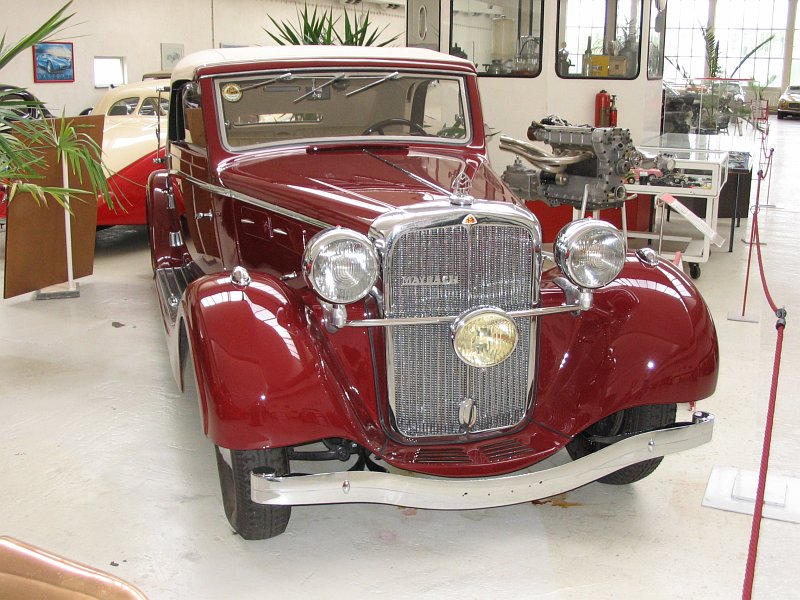Description
The Maybach SW 38 Cabriolet by Spohn was one of the most exquisite and sought-after luxury convertibles of the late 1930s. Built on the advanced SW 38 chassis and bodied by Spohn — Maybach’s closest and most prestigious coachbuilding partner — it combined state-of-the-art engineering with some of the finest automotive craftsmanship of the pre-war era. Among all SW-series Maybachs, the Spohn cabriolets are regarded as some of the most elegant, refined and beautifully proportioned bodies ever mounted on a German chassis.
The SW 38 chassis, introduced in 1936, marked the second generation of Maybach’s independent-suspension series. It was powered by a 3.8-litre straight-six engine equipped with a clutch-operated Roots-type supercharger, delivering around 150–160 horsepower. Although smaller in displacement than the colossal W-series engines of the 1920s, the SW power unit was significantly more sophisticated. It offered exceptional smoothness, quiet operation and abundant torque, characteristics that suited both formal limousines and glamorous open tourers. Its refinement was a direct product of Maybach’s aviation heritage, which emphasised precision engineering and high-quality metallurgy.
Suspension was one of the SW 38’s most important technical features. The Schwingachse swing-axle independent rear suspension, paired with independent front suspension, allowed the car to ride with a softness and composure few competitors could match. Combined with a long wheelbase and a rigid box-section chassis frame, it gave the SW 38 remarkable stability and comfort on the uneven roads of the 1930s. The car’s semi-automatic Maybach preselector transmission — with its torque converter and clutch-free shifting under most conditions — offered an unusually smooth and relaxing driving experience, making the SW 38 ideal for both chauffeur duties and owner-driven grand touring.
The Spohn cabriolet body elevated this mechanical sophistication into a visual and tactile work of art. Spohn’s Ravensburg workshop had an unusually close relationship with Maybach, and their designs reflected a deep understanding of the chassis proportions and the marque’s luxury ethos. The SW 38 Cabriolet Spohn typically featured long, flowing fenders; a gracefully tapered tail; a low, elegant beltline; and finely balanced door and window proportions. The soft-top was beautifully engineered, folding neatly into a sculpted rear deck to preserve the car’s clean lines when open. Spohn’s panel work was executed entirely by hand, each piece shaped to perfection and finished with deep, lustrous paint.
Inside, the Cabriolet Spohn displayed craftsmanship of the highest order. The cabin was trimmed in hand-sewn leather of premium quality, complemented by thick carpeting, polished hardwood veneers, and finely machined metal fittings. The dashboard featured elegant, aircraft-inspired instrumentation — a nod to Maybach’s engineering origins. Many examples were fitted with luxurious touches such as fold-out picnic tables, vanity cases, smoking sets, special interior lighting, and bespoke storage compartments, depending on the client’s wishes. With the roof lowered, the cabin became a refined open-air lounge, showcasing both comfort and craftsmanship in equal measure.
On the road, the SW 38 Cabriolet Spohn delivered a superb combination of power, refinement and stability. The supercharged straight-six provided strong, seamless acceleration, while the independent suspension allowed the car to glide over rough surfaces with calm authority. Steering was steady and predictable, well matched to the car’s grand-touring nature, and braking performance — delivered by large mechanical or hydraulic drums depending on year — was solid for a vehicle of this class and period. Period road testers often praised the SW 38 series for its composure at speed and its ability to cover long distances without driver or passenger fatigue.
Production numbers of the SW 38 series were very limited, and Spohn-bodied cabriolets were among the rarest configurations. Each car was a bespoke commission, tailored to the preferences of a wealthy private client, which means no two surviving examples are identical. Their rarity and exquisite craftsmanship make them some of the most valuable pre-war German convertibles in existence.
Today, the Maybach SW 38 Cabriolet Spohn is considered a masterpiece of 1930s automotive design — a perfect fusion of mechanical innovation, elegant coachbuilding and bespoke luxury. It remains one of the most admired body styles ever mounted on a Maybach chassis and a symbol of pre-war Germany’s highest achievements in engineering and craftsmanship.

